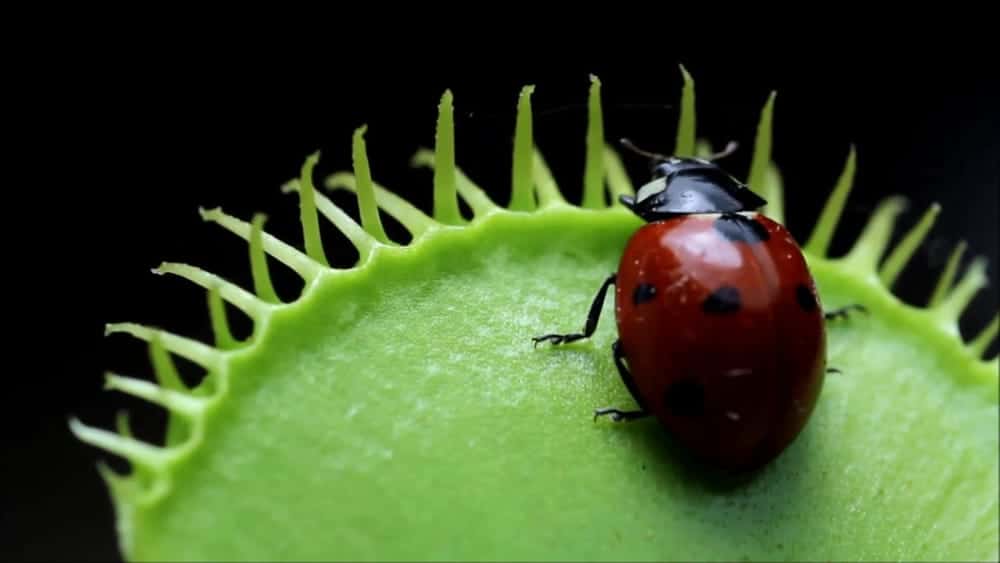Venus Fly Traps are native to North America, and the Eastern United States, and thrive in swamps. They use leaves to trap insects. With this line of plants, you can grow them in pots.
During the care process, you always wonder can venus fly traps eat ladybugs. Let’s find out how the traps work and the answers to the questions above.
As a result, you can be sure that venus fly traps can eat ladybugs. Take the time to learn more about the process in this article.
Can Venus Fly Traps Eat Ladybugs? What Can You Feed Venus Flytraps?
Venus fly traps have jaws called “caps” with two lobes. In each tree’s cap, thick hairs are responsible for preventing prey from escaping the traps. When prey touches the feathers (trichomes), the trap closes and grips them. You need to make sure the environment is moist for the plants for the traps to work properly.
The process of catching prey of the venus flytrap plant takes place quickly in a short time. Therefore, most prey falls into this trap. The traps secrete a red liquid to help the plant digest the insects. Food digestion time is 10 days. And each trap only works once until a new trap replaces it.
Venus Flytrap has the scientific name of Dionaea muscipula. And it photosynthesizes to get energy from the sun in addition to catching prey with protein from insects. Venus Fly Traps can eat ladybugs and other small animals such as worms, slugs, flies, ants, and crickets with the characteristic of carnivorous plants.

What Foods Can’t You Feed Venus Flytraps?
Venus Flytraps are known as one the predatory plants that have the feature of eating meat. However, they cannot eat meat, cheese, sugar, table salt, bread, etc. They can only eat insects and small invertebrates with specific amounts of nitrogen. Let them catch natural prey or provide partial support. In addition, predatory plants can survive for long periods without additional food.
Does The Exoskeleton Of The Ladybug Affect The Venus Flytraps?
There are some debates on this issue, such as the shells of ladybugs taking a lot of energy to digest, or that the ladybugs contain a lot of acids that affect the vitality of Venus Flytraps. However, these problems do not seem to affect plant growth much. You can enhance plant care with the right foods or nutrients.
To quickly digest the hard exoskeleton of a ladybug, Flytrap takes more time and energy. This process presents a high risk of infection and has a damaging effect on the plant. You can consider taking the best care of the tree.
Some Notes When Taking Care Of Venus Flytraps
If you grow this strain, place them in a location with direct sunlight. Photosynthesis helps plants secrete red juice to absorb food. Plants need the necessary moisture and proper dormancy.
For low-light environments, you can use artificial lighting with standard T5 fluorescent lamps. The suitable soil type for this strain is peat moss especially sphagnum moss.
Venus Flytraps need pure water to grow well. They do not need nutrients from fertilizers. The best nutrition comes from food. Insects must be 1/3 the size of the trap for good digestion. They take a week to digest their prey. Therefore, you let them do their job with the lids closed.
Prey plants usually flower in the spring. However, this process causes the plant to lose a lot of energy. So, you should cut flowers with a length of 5cm to avoid affecting the plant. Except for obtaining seeds for propagation, the flowering process is not necessary. You can order seeds at any sales site.
Read more: Do Venus Fly Traps Eat Gnats?
The Special Things Of The Traps
There are hundreds of different varieties of Venus Flytraps with 2.5cm long traps. They can also reach a maximum length of 5cm. The color of the traps can also be blue, red, or a combination of both.
If planted outside, Venus Flytraps will catch a lot of food. You can also change this process and feed them yourself with the appropriate insects. Lightly touch the feathers on both sides of the trap to stimulate the digestion of food and help the plant grow well. Many videos guide the process of feeding the Dionaea muscipula. You can observe and learn more from experience.
Most Venus Flytrap emits a seductive sweet scent to lure insects into their traps and prey. This natural food source helps them grow throughout their life cycle.
With the right type of soil, you can take care of predatory plants. However, they do not need to be watered too much because the plants can become waterlogged and drown. Check for proper humidity to help plants grow well with direct light.
The process of catching prey stimulates you to observe. Raise a Dionaea muscipula and experience the process.
On The Whole
Venus Flytrap can eat ladybugs without too much ill effect. Digestion can take a long time or have a small effect on plant vigor due to the hard skeleton of ladybugs or the acidity secreted by these insects.
You can feed worms, or other small invertebrates we recommend above. Enjoy the wonders of nature!